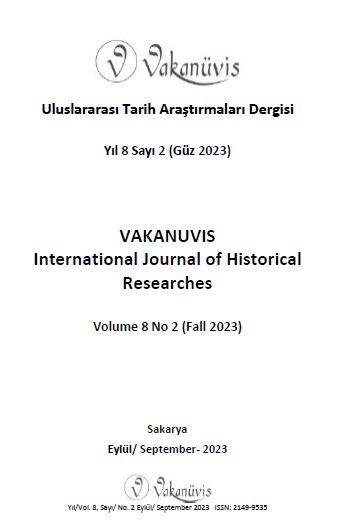Visual Traces of Struggle for Dominance in The Western Mediterranean on Foreign Policy: Reflections of The Franco-Dutch War (1672-1678) in Sicily
Visual Traces of Struggle for Dominance in The Western Mediterranean on Foreign Policy: Reflections of The Franco-Dutch War (1672-1678) in Sicily
Author(s): Rumeysa I. YaylaSubject(s): Visual Arts, Military history, Political history, 17th Century, Peace and Conflict Studies
Published by: Serkan YAZICI
Keywords: Mediterranean; Franco-Dutch War; Sicily; Palermo; Visual Documents;
Summary/Abstract: The Mediterranean Basin has been the starting point of many civilizations since prehistoric times. The political, commercial, economic, and cultural activities carried out in this region for centuries have played an important role in the states trying to dominate this region. Especially, the Eastern and Western Mediterranean basins on both sides of the north-south transition, on which Sicily is located, have formed a strong field of struggle throughout history. Sicily, the largest island of the Mediterranean, has witnessed the wars of many states with its position as a crossroads. One of them is the Franco-Dutch Struggle between 1672-1678. The battles of Messina, Stromboli, Augusta, and Palermo, which formed the Sicilian front of the war between 1674 and 1676, reveal the richest visual data of the race for dominance in the Western Mediterranean. Because these encounters are highly significant for the future of the Mediterranean, especially following the Battle of Lepanto. The aim of the article is to present the established dominance at this point through visual evidence. What is important here is that painters, by creating a pictorial template from evolving images due to shifting power dynamics, have applied this to scenes of warfare. Moreover, a crucial aspect is that these works have been produced in a contemporary timeframe alongside the battles. Furthermore, these paintings have not only served as pieces of art but also as political tools. In this article, the identified war scenes are discussed in a chronological order, without emphasizing technical distinctions. This way, symbolic connotations that revive the prideful aspect of the achieved victory are attempted to be brought back to memory. To a certain extent, the visual representation of the sentiment of heroism directed towards the past is highlighted, focusing on pictorial indicators.
Journal: Vakanüvis- Uluslararası Tarih Araştırmaları Dergisi
- Issue Year: 8/2023
- Issue No: 2
- Page Range: 1619-1652
- Page Count: 34
- Language: English

